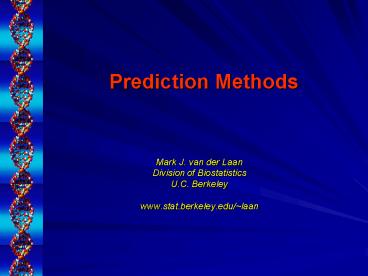Prediction Methods - PowerPoint PPT Presentation
1 / 14
Title:
Prediction Methods
Description:
Finds predictors that are Boolean (logical) combinations of. the original (binary) predictors. Logic Regression: Classification and Regression Algorithm ... – PowerPoint PPT presentation
Number of Views:78
Avg rating:3.0/5.0
Title: Prediction Methods
1
Prediction Methods
- Mark J. van der Laan
- Division of Biostatistics
- U.C. Berkeley
- www.stat.berkeley.edu/laan
2
Outline
- Overview of Common Approaches to Prediction
- Regression
- randomForest
- DSA
- Cross-Validation
- Super Learner Method for Prediction
- Example
- Conclusion
3
If Scientific Goal . . .
- Predict phenotype from genotype
- of the HIV virus
. . . Prediction
If Scientific Goal . . .
For HIV-positive patient, determine importance of
genetic mutations on treatment response
. . .Variable Importance!
4
Common Methods
Linear Regression
Penalized Regression
Ridge Regression
Lasso Regression
Least Angle Regression
Simple, less greedy Forward Stagewise regression
5
Common Methods
Logic Regression
Finds predictors that are Boolean (logical)
combinations of the original (binary) predictors
Semi-parametric Regression
Non-parametric Regression
Polymars Uses piece-wise linear splines
Knots selected using Generalized Cross-Validation
6
Random Forest
Breiman (1996,1999)
- Classification and Regression Algorithm
- Seeks to estimate EYA,W, i.e. the prediction
of Y given a set of covariates A,W - Bootstrap Aggregation of classification trees
- Attempt to reduce bias of single tree
- Cross-Validation to assess misclassification
rates - Out-of-bag (oob) error rate
sets of covariates, W W1 , W2 , W3 , . . .
- Permutation to determine variable importance
- Assumes all trees are independent draws from an
identical distribution, minimizing loss function
at each node in a given tree randomly drawing
data for each tree and variables for each node
7
Random Forest
- The Algorithm
- Bootstrap sample of data
- Using 2/3 of the sample, fit a tree to its
greatest depth determining the split at each node
through minimizing the loss function considering
a random sample of covariates (size is user
specified) - For each tree. .
- Predict classification of the leftover 1/3 using
the tree, and calculate the misclassification
rate out of bag error rate. - For each variable in the tree, permute the
variables values and compute the out-of-bag
error, compare to the original oob error, the
increase is a indication of the variables
importance - Aggregate oob error and importance measures from
all trees to determine overall oob error rate and
Variable Importance measure. - Oob Error Rate Calculate the overall percentage
of misclassification - Variable Importance Average increase in oob
error over all trees and assuming a normal
distribution of the increase among the trees,
determine an associated p-value - Resulting predictor set is high-dimensional
8
Deletion/Substitution/Addition Algorithm(DSA)
9
(No Transcript)
10
(No Transcript)
11
(No Transcript)
12
(No Transcript)
13
(No Transcript)
14
(No Transcript)































